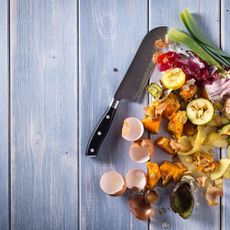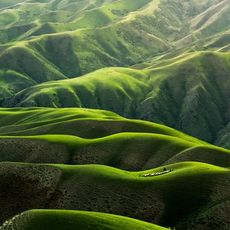What Ingredients Certifications Does Blueland Have?

Written by: John Mascari, COO @Blueland
March 16, 2021
Have you ever looked at the list of certifications for a product and had no idea what any of them meant? More than ever, consumers are educating themselves on the impact of the products they purchase. Because of this, there many certifications, organizations, third party audits, and classifications that assess and rate the safety of consumer products. If you take a look at our website, you’ll find various certifications for our specific products. These include:
- The Platinum Material Health Certificate from Cradle to Cradle
- USDA BioPreferred
- EPA Safer Choice
- Leaping Bunny
- EWG
But what do these mean? In this post, we’re diving into what each certification or classification means and how they apply to our products.
What Is Cradle to Cradle?
The Cradle to Cradle Certified Products Program and Institute were developed to establish a global standard for products that are made responsibly, safe for people and the planet, and are part of a circular system. The vision behind Cradle to Cradle is to create a world where safe products are manufactured in a sustainable circular economy to maximize health and wellbeing for consumers and the environment. The Institute aims to nourish collaborative partnerships that equip businesses, governments and other contributors with solutions to innovate the way products are manufactured Cradle to Cradle. Through these partnerships, businesses can submit their products for assessment to potentially become Cradle to Cradle Certified.
What Is A Platinum Material Health Certificate From Cradle To Cradle?
All of our formulations have received the Platinum Material Health Certificate from Cradle to Cradle. The Cradle to Cradle Certification has different levels including Basic, Bronze, Silver, Gold, and Platinum being the highest rating. When a company assesses their products and practices through the Cradle to Cradle Certified program, MBDC (Cradle to Cradle’s assessment partner) reviews documentation and data through a rigorous process to determine the certification level the company has achieved.
What Are The Qualifications For A Cradle To Cradle Certification?
- MDBC looks at the material health of the products, which includes an examination of the ingredients throughout the supply chain. The goal for the highest rating is to omit all toxic chemicals from formulations and ensure that those formulations are indeed safe for consumers and the planet. However, they don’t assess this on an individual basis. MBDC assesses the product against the Product Standard criteria.
- The next component of the certification is assessing if the company is actively participating in a circular economy. This means that the products are either designed to biodegrade safely or be recycled into new products. To increase your certification level, special attention must be paid to recovering materials and keeping them within the circulatory system.
- MBDC also assesses the company’s efforts at carbon-neutral manufacturing by running operations completely on renewable energy. While we’re working towards our carbon neutral certification, we’re happy to share that we’ve audited all emissions associated with the business and offset them in partnerships with the Southern Plains Land Trust. Another component of manufacturing is the use of water. MBDC examines that the manufacturing process regards water as an important resource and that polluted water is not expelled into our water systems. By formulating our tablets and formulations in dry form, we were able to eliminate the use of water in our manufacturing process. So this means that no water is expelled in the manufacturing of our formulations.
- The last component that MBDC assesses for the Cradle to Cradle certification is social fairness and the treatment of teams throughout the supply chain. While we’re actively working towards becoming B Corp Certified, we do practice and adhere closely to those values in our business practices and lives.
- Once MBDC has concluded their assessment, all of the documentation and materials are given to Cradle to Cradle, along with a certification recommendation. Cradle to Cradle reviews the information and asks the brand any necessary additional questions as they determine the certification level. Based on that information and how well a company’s practices and formulations adhere to the standard, Cradle to Cradle then awards the company a specific level of certification: Basic, Bronze, Silver, Gold, or Platinum.
What Does Biobased Mean?
Biobased products are derived from raw materials such as plants and other renewable agricultural, marine, and forestry materials. To break it down further, biobased products are assessed on how much “new” carbon is in a substance as opposed to the amount of “old” carbon it contains. For example, a plant or a tree contains “new” carbon, while coal contains “old” carbon as it has become inorganic carbon.
What Does A USDA BioPreferred Certification Mean?
The USDA BioPreferred program assesses the ingredients profile of specific products to determine what degree the product is biobased. Biobased products that are awarded this certification should provide an alternative to conventional products that are derived from petroleum. The USDA assesses the percentage of biobased materials or ingredients in a product by evaluating by the amount of “new” organic carbon in a product divided by the sum of the “new” organic carbon and the “old” inorganic carbon. Water is excluded in this calculation and the test method ASTM D6866 is used to quantify this value. The USDA then compares this percentage to their standard to determine whether a product will receive the BioPreferred certification.
So, Are Blueland Products Biobased?
- Our Bathroom tablet is 78% biobased
- Our Multi-Surface tablet is 74% biobased
- Our Glass + Mirror tablet is 61% biobased.
- Our Dishwasher tablets are 98% biobased
- Our Powder Dish Soap is 96% biobased
- Our Laundry tablets are also 96% biobased
However, we took it a step further to determine the biodegradability of our products as there are inorganic ingredients in our formulations as well. To determine the biodegradability of our ingredients/formulations, we rely on testing standards and guidelines established by the Organization for Economic Cooperation and Development (OECD). At least 98% of the organic ingredients (ingredients containing carbon bonded with hydrogen, oxygen, and other elements) in our products are biodegradable, but we also use inorganic ingredients in our formulations (ingredients that do not contain carbon bonded with hydrogen, oxygen, and other elements).
One example is sodium bicarbonate (baking soda). These ingredients are excluded from the established OECD tests because they do not biodegrade by the classic definition: the process by which organic substances are decomposed by microorganisms. All of the inorganic chemicals we use in our products are reported without any known toxic effects for aquatic organisms and the formulations overall.
What Does The EPA Safer Choice Certification Mean?
The EPA’s Safer Choice label is aimed at helping consumers find products with safe ingredients without sacrificing quality or performance. Companies submit their documentation for review on a voluntary basis as they have rigorously researched and formulated their products to meet the Safer Choice criteria.
What Are The Qualifications For The EPA Safer Choice Certification?
The first step in the process is for the EPA to review all of the chemical ingredients in the product. The ingredients must meet strict criteria for both human health and the environment, including carcinogenicity, reproductive/developmental toxicity, toxicity to aquatic life, and persistence in the environment. If the product meets this criteria, it means that the formulation is safer for the consumer, their family, and pets, as well as worker’s health in the supply chain and fish and the environment.
Other components of the ingredients that the EPA evaluates include if VOCs (volatile organic compounds) are included, in the effort to minimize indoor air pollution and respiratory illnesses. And the pH level of products are evaluated against the standard to ensure that the product minimizes potential for skin or eye irritation.
Finally, partners that are evaluated for the Safer Choice label must provide proof of sustainable packaging against criteria defined in the Safer Choice Standard. For example, the Safer Choice Standard requires that any paperboard used in packaging is made or is working towards composition of 100% recycled content.
Which Blueland Products Are EPA Safer Choice Certified?
Currently, our cleaning tablets, hand soap tablets, and Dishwasher tablets are EPA Safer Choice certified. However, our other products are currently awaiting assessment and only use ingredients on the EPA Safer Chemical Ingredients List.
What Does The Leaping Bunny Certification Mean?
Leaping Bunny is committed to providing consumers with the ability to identify products that have not been tested on animals and do not contribute to animal cruelty. This means that the formulation and ingredients of Leaping Bunny certified products have not been tested on animals. Additionally, the company has not purchased ingredients, formulations, or products from a third party or supplier that conducted, commissioned, or been party to animal testing on the ingredient, formulation, or product purchased. Furthermore, the company must implement a Supplier Monitoring System to ensure that any suppliers or third parties will not conduct or commission animal testing on any ingredients, formulations, or products they purchase. This Supplier Monitoring System is recommitted annually and is submitted to an Independent Audit to ensure compliance and non-bias.
All of Blueland’s formulations are Leaping Bunny Certified.
What Does It Mean To Be EWG Verified?
The EWG (Environmental Working Group) Verified mark is becoming an increasingly important label for consumers to see on the shelf due to their strict criteria and standards for health and safety. EWG currently evaluates and awards labels for skincare products, cleaning products, and now baby care products. These categories of products have different sets of criteria, so for the purpose of our products, we will note the criteria established for cleaning products.
EWG first and foremost evaluates products on health standards. Products that receive the label must be formulated to minimize potential harm to people and the environment, disclose all intentionally added ingredients, fragrance allergens, and nanomaterials. They must meet stringent air quality standards and pass testing for shelf stability in an appropriate period of time.
Companies that are awarded the label for these efforts must also disclose the results of third party efficacy testing, follow standard ingredient naming guidelines, follow best manufacturing practices, and submit all information on potential substantial product hazards to the Consumer Product Safety Commission or the EPA if the product is a registered disinfectant, as well as EWG. Should EWG award a product with their label, they also reserve the right to perform random product testing at any time to make sure the formulation is still in compliance with their standards. Additionally, EWG reviews and updates their “Unacceptable” and “Restricted” lists annually to ensure that no harmful ingredients are excluded from these important lists.
What Blueland Products Are EWG Verified?
Currently, our Dishwasher tablets are the first and only dishwasher detergent that is EWG verified. While we are awaiting EWG assessment of our other products, our products use none of the ingredients on the EWG Unacceptable List.
Learn more about Blueland ingredients and what they mean here.


